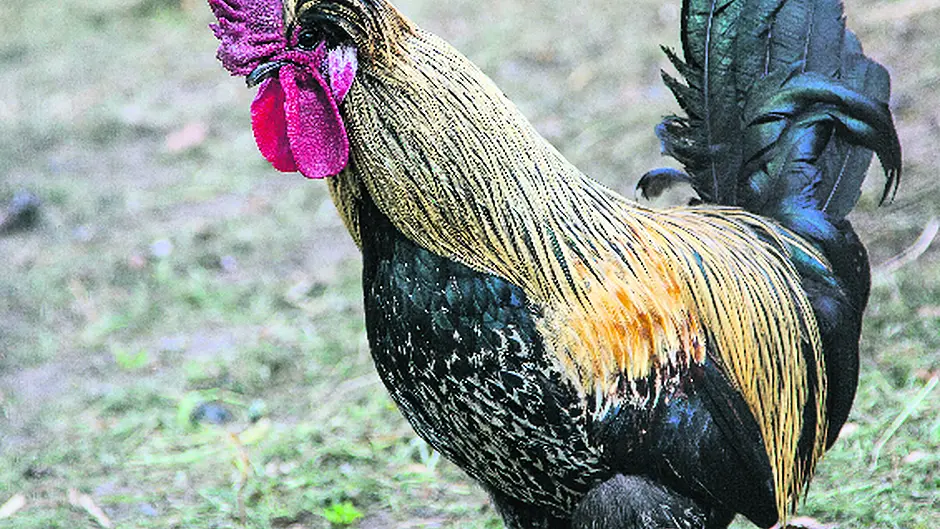Wildlife with an amateur observer
There are a few archaic customs around the Christmas period that involved cruelty to birds. Aside from the fate of the unfortunate turkey, the poor wren was traditionally persecuted and killed on St Stephen’s Day by the Wren Boys. This was also the day when vicious cockfights were held in Ireland, a practice that is now outlawed thankfully.
Humans have a very long relationship with domestic hens and cocks. Chickens were domesticated several millennia ago and have been widely used by man all over the world. While they cannot be considered ‘wildlife’ anymore, domestic chickens fascinate many people, myself included.
Wild bird ancestry
Domestic chickens from all around the world today are direct descendants of wild birds from southern Asia. Their ancestors, the red junglefowl (Gallus gallus) and grey junglefowl (Gallus sonneratii) still exist as wild birds in rainforests today.
Over the millennia of breeding, hundreds of varieties of different colours, shapes and sizes have emerged. The males are known as cocks, roosters or stags while females are hens, biddys or partlets.
There is a very strict hierarchy amongst domestic chickens – the ‘pecking order’. In actual fact, there are two pecking orders, as the cocks and hens each have their own individual systems. The dominant cock ‘rules the roost’ and, when he dies, the next rooster in line step into the role.
The cock is very aggressive in defending his position as ‘cock of the hoop’ and will fight to the death against a rival. We have a description of a rooster from O’Sullivan Beare in the 17th century:
‘The dunghill-cock carries his ferocity before him, with his comb lifted up, his neck erect, his haughty gait, and his sickle-shaped tail ... he strives after the kingship of his own kind ... for this reason, fighting is fierce among cocks.’
The tendency of the cock to fight his rivals gave rise to the barbaric practice of cockfighting. This is where two birds generally fight to the death while onlookers bet on the outcome. This was considered to be a traditional pastime all around Europe in times past. It was outlawed in Ireland and Britain in the 19th century, however, it still takes place in many parts of the world today.
Chickens in Ireland
Chickens were most likely introduced to Ireland during the first few centuries AD. However, they were not common here until well into the 14th century. Their Irish name, ‘cearc clóis’ means ‘yard-hen’. Traditionally, they were generally allowed to roam around at will during the day, which sometimes caused trouble with the neighbours. At night, they were brought into the house, usually into the warm kitchen.
Chickens were very highly valued in Ireland. A 10th century saying has it that ‘it is good that there should be a hen on a farm’. In law, the value of a laying hen was two bushels of grain while that of the rooster was just one bushel. When the cock was no longer considered fertile, his value was reduced to half a bushel as food.
Brehon Law also had it that the size of the green of the farm could be measured as far as ‘the sound of a bell or the crowing of a cock reaches’.
Their main purpose was egg-laying as the chickens themselves were rarely eaten. A hen was a valuable asset as she provided eggs year round, including the lean months of winter.
On the rare occasion when a bird was to be eaten, it was usually the fattened cock and it was generally for a specific celebration. The feathers were used in pillows and mattresses.
Philip O’Sullivan Beare tells us that, in 17th century Ireland; ‘farmyard hens are those very common ones we see produced not only in villages but also in towns, and we admit that their flesh, feathers and eggs ... are of great use to man’.
Myth and Folklore
It’s understandable that these ubiquitous birds feature strongly in myth and folklore. There are numerous pishógs associated with them, some of the contradictory.
One of the best-known Irish proverbs is the one that says ‘a whistling woman and a crowing hen will bring no luck to the house they are in’. On a rare occasion a hen will crow. When this happened in times past, the bird was considered to be bewitched and was sold or killed immediately.
Hens and chickens coming into the house were considered lucky. A rooster coming into the house foretold of a visitor. However, a cock crowing through a door or window was a warning of a death in the family.
White cocks were considered to bring luck while black ones were associated with sacrifice. A crowing cock was believed to keep the pookas and fairies away at night. A ‘March cock’ was particularly good at keeping the fairies at bay. This was a cock that had hatched in March whose parents had both also hatched in March.
There is a lot of folklore surrounding eggs. After an egg was eaten, the shells were crushed or thrown in the fire as otherwise it was believed that they would become the home of the fairies.
In Beara, a somewhat bizarre belief had it that the first egg laid by a black hen was good for the voice. If a person drank the egg cold, without cooking it, for three mornings in a row, they would good at singing. And if you wanted to bring bad luck to your neighbour, you’d put rotten eggs in his haystacks.
I am lucky to have a neighbour who shares the bounty of his hens and ducks with us all. His Rhode Islands, Bantams and Silkies are great roadside entertainment and they provide this townland with delicious eggs. However, I’ve come to love his duck eggs even more. But that’s another story.








